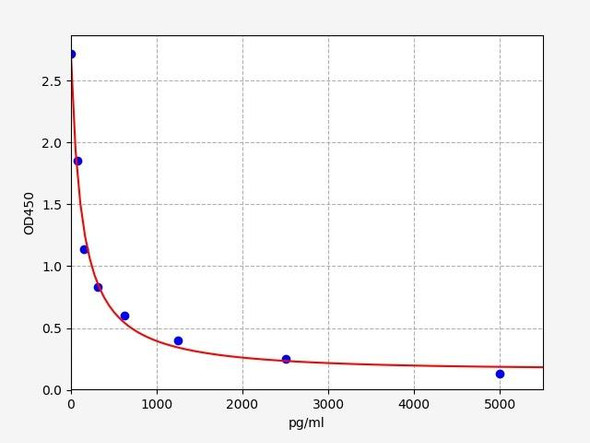Description
Rat Apelin PharmaGenie ELISA Kit (SBRS0116)
| Product SKU: | SBRS0116 |
| Size: | 96T |
| Application: | This kit is designed to target the C-terminus of the 77-aa apelin peptide and therefore is expected to detect all active forms of Apelin including Apelin-36, Apelin-31, Apelin-28 and Apelin 13 can be detected. Cross Reactivity: This kit shows no cross-reactivity with any of the cytokines tested: Ghrelin, Nesfatin, and NPY. |
| Uniprot: | Q9R0R3 |
| Gene ID: | 58812 |
| Gene Names: | APEL / APLN |
| Synonyms: | Apelin (APJ endogenous ligand) [Cleaved into: Apelin-36 Apelin-31 Apelin-28 Apelin-13] |
| Target Species: | Human, Mouse, Rat |
| Compatible Sample Types: | Cell Culture Supernatants, Serum |
| Design Principle: | Competition-based |
| Method of Detection: | Colorimetric |
| Quantitative/Semi-Quantitative: | Quantitative |
| Range: | 0.1-1,000 ng/ml |
| Sensitivity: | 15.8 ng/ml |
| Recommended Dilution: | Human: 2X, Mouse: 2X, Rat: 2X |
| Storage/Stability: | Standard, Biotinylated Apelin C-Terminus peptide, and Positive Control should be stored at -20°C after arrival. Avoid multiple freeze-thaws. The remaining kit components may be stored at 4°C. Opened Microplate Wells and antibody (Item N) may be stored for up to 1 month at 2 to 8°C. Return unused wells to the pouch containing desiccant pack and reseal along entire edge. |
- Pre-Coated 96-well Strip Microplate
- Wash Buffer
- Standard Peptide
- Assay Diluent(s)
- Biotinylated Peptide
- HRP-Streptavidin
- TMB One-Step Substrate
- Stop Solution
- Assay Diagram
- Positive Control Sample
- Capture Antibody
- Technical Manual
Other materials and equipment required:
The Assay Genie Rat Apelin PharmaGenie ELISA Kit (SBRS0116) will require other equipment and materials to carry out the assay. Please see list below for further details.
- Distilled or deionized water
- Precision pipettes to deliver 2 ul to 1 ml volumes
- Adjustable 1-25 ml pipettes for reagent preparation
- 100 ml and 1 liter graduated cylinders
- Tubes to prepare standard and sample dilutions
- Orbital shaker
- Aluminum foil
- Saran Wrap
- Absorbent paper
- Microplate reader capable of measuring absorbance at 450nm
- SigmaPlot software (or other software that can perform four-parameter logistic regression models)
- Prepare all reagents, samples and standards as instructed.
- Add 100 ul detection antibody to each well.
- Incubate 1.5 h at RT or O/N at 4°C.
- Add 100 ul standard or sample to each well.
- Incubate 2.5 h at RT.
- Add 100 ul prepared streptavidin solution.
- Incubate 45 min at RT.
- Add 100 ul TMB One-Step Substrate Reagent to each well.
- Incubate 30 min at RT.
- Add 50 ul Stop Solution to each well.
- Read plate at 450 nm immediately.
Apelin, an endogenous ligand for the G-protein-coupled APJ receptor, has been recently extensively studied in obesity research. It is not only expressed in adipocyte tissue, but also widely expressed in various other organs such as the heart, lung, kidney, gastrointestinal tract, brain, adrenal glands, endothelium, and human plasma. Apelin is derived from a 77-amino-acid prepropeptide that is cleaved into a 55-amino-acid fragment and then into shorter forms. The physiologically active form is thought to be apelin 36, although the pyroglutamylated form of apelin 13, which is also produced endogenously, is more potent. Studies have shown the association between apelin and obesity. Apelin has higher circulating levels in obesity. Insulin exerts a positive action on adipocyte apelin production. Apelin also regulates fluid homeostasis, playing an important role in the hypothalamic regulation of food and water intake, and pituitary hormone release. In addition to its role in obesity, apelin acts as a mediator of cardiovascular control, including for blood pressure and blood flow. It is one of the most potent stimulators of cardiac contractility yet identified, and plays a role in cardiac tissue remodeling. Apelin levels are increased in left ventricles of patients with chronic heart failure and also in patients with chronic liver disease.






